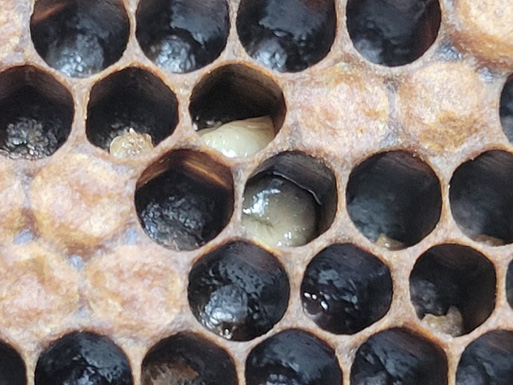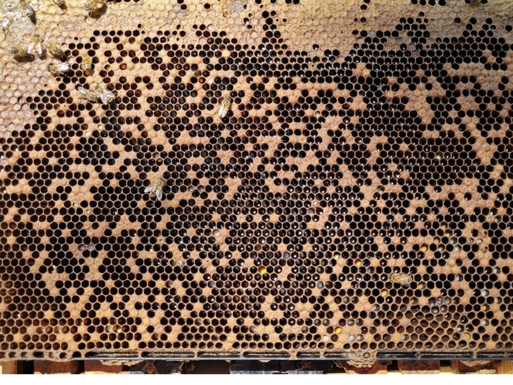High Varroa Mite Loads in Nucleus Colonies (Nucs) of Honey Bees
The number of managed honey bee colonies in the U.S. has ranged between 2.6 million and 2.9 million over the last several years. This estimate has remained fairly stable despite extremely high annual colony losses of more than 40 percent throughout much of the last decade. High annual losses have many causes, but the greatest factor during the last 30 years has been the varroa mite and the viruses it vectors to honey bees. This suggests that beekeepers must work continuously to make new colonies as replacements, which threatens the long-term economic sustainability of commercial beekeeping.
The Bee Informed Partnership has been compiling survey data about colony losses in the U.S. since 2007. Annual colony losses remain critically high in the U.S. Last year (April 2022 to April 2023), the average annual colony loss was 48 percent. The average summer (April to October 2022) loss was about 25 percent, and the average winter (October 2022 to April 2023) loss was 37 percent.
The data in the above study was organized by size of beekeeping operations. Three classes of beekeepers are defined by the numbers of colonies they manage. Hobbyists or small-scale beekeepers manage 1–50 colonies. Sideliners manage 51–500 colonies, and commercial beekeepers manage more than 500 colonies. As in many previous years, hobbyist/small-scale beekeepers tended to have higher annual losses than commercial beekeepers. Additionally, hobbyists/small-scale beekeepers had significantly higher summer losses than commercial beekeepers. The three types of beekeepers had similar mortality rates for colonies during the winter.
The primary reason given for winter losses by all types of beekeepers was varroa mites and the viruses they vector to bees. Secondary reasons for winter losses included adverse weather, starvation, and queen issues. The primary reason for summer losses by all types of beekeepers was queen issues, but varroa mites and adverse weather were secondary reasons.
Varroa mites affect honey bees in several ways. They vector more than 20 different viruses to honey bees. Many of these viruses spread rapidly in colonies and eventually lead to so much sickness in the bee population that a colony slowly dwindles and dies. Some of the viruses most closely associated with colony deaths include deformed wing viruses, acute bee paralysis virus, and Israeli acute paralysis virus. Additionally, some of these viruses can be vectored directly into queens and drones. Thus, some queen issues may be ultimately derived from viral infections related to varroa mites. It is imperative that new colonies of bees established in the spring start with as low a level of viruses and/or varroa mites as possible.
Unfortunately, some starter units of honey bees may contain high varroa mite infestations at the time of purchase during the spring. Starter units may be package honey bees or nucleus colonies (nucs). Most starter colonies sold in Mississippi are nucs. Nucs are small colonies that are obtained by removing adult bees and combs of brood from existing source hives that are generally strong colonies. If the source colonies are high in varroa mite loads, then the subsequent nucs derived from those colonies will also have high mite loads. The following case study illustrates the problem.
Case Study
In May 2023, five nucs were purchased from a single supplier (source A in Table 1) in Mississippi. All nucs were the standard colony size of about 10,000 bees in a five-frame-deep box. Nucs were kept in an apiary, and bees were allowed to freely forage until the night before installation, when nucs were sealed for transportation to the site of installation. The nucs were transported by air-conditioned car to four different clients. One nuc was installed by a customer in Tupelo on May 20, and another went to a customer in Corinth on the same day. One nuc was installed by a customer in Starkville on May 21, and the last two nucs were installed by a client in Greenwood on May 22.
All five nucs looked good at installation. The bee population appeared normal, and capped brood patterns in all colonies seemed good and solid (very few missed capped cells). All marked queens were seen. Additionally, all stages of brood were seen in the colonies. Each nuc had plenty of stored honey and bee bread. Everything seemed normal, and there were no obvious symptoms (e.g., deformed wings or hairless bodies) of viral diseases in the adult bees.
After installing the bees into standard Langstroth hives, each customer added sucrose syrup (one part water to one part syrup) to division board feeders to help them grow new combs from frames of foundation. The nucs were received later in the year than is typical, and the spring honey flow was already waning at some of the sites. This circumstance was expected because of the cold and rainy April that occurred in north-central Mississippi. The nucs were not expected to grow as well as those that would have been installed in mid-April of a typical year. However, the nucs would likely grow a little and could be stabilized into a fairly strong colony by July. They just needed a little help in growing combs with the syrup-feeding regime.

The Starkville customer noticed a weak population of bees in the colony that was started there, and upon inspection, the bee population was dramatically lower than just a week before. The capped brood pattern had become very spotty (Figure 1) within 1 month of installation, and there were numerous browning and dead bee larvae. The dead brood looked like a case of European foulbrood (EFB) without the odor. EFB tends to be a disease of the cooler spring months, and it usually clears up by the end of May. It seemed more likely that the poor brood pattern was caused by viruses killing young brood, and that the viruses came from a high varroa mite load.
A sample of 400 bees (about one-half cup of bees) was taken from brood combs of the Starkville hive and washed with alcohol to dislodge the mites. The client hated to kill 400 bees from an already weak colony, but an alcohol wash gives an accurate estimate of the mite load. Remarkably, 27 varroa mites were washed from 400 bees, which is a mite load of 6.75 percent. The economic threshold for varroa mites during the summer months is 3 percent—the mite load in this hive was more than double that value.
The other clients were alerted to check the mite loads in their nucs. Four of the five nucs had high mite loads and showed obvious signs of viral diseases (Table 1). The client in Tupelo had a full-sized hive that was grown from a nuc purchased in the previous year. That colony boomed with lots of bees and plenty of stored honey. It was also sampled as a precaution to determine if it needed mitigation for a high mite load. However, the mite load was only 1.8 percent, and the customer will be able to extract honey before treating the colony for varroa mites.
The client in Greenwood had obtained a second nuc from another source earlier in the year, and that colony (colony 4 in Table 1) was relatively healthy. It had the lowest mite load of any colony sampled in this case study. The client in Corinth had the luck of the draw among the five new nucs—the nuc (colony 1 in Table 1) at that location was growing well with a relatively low mite load.
|
Location |
Source |
Nuc or Colony Number |
Mite Load (%) |
Condition |
|
Corinth |
A |
1 |
1.25 |
good brood pattern; about 12,000 bees |
|
Greenwood |
A |
2 |
6.00 |
very spotty brood; about 5,000 bees |
|
A |
3 |
4.80 |
slightly spotty pattern; about 8,000 bees |
|
|
B |
4 |
0.50 |
good brood pattern; about 12,000 bees |
|
|
Starkville |
A |
5 |
6.75 |
very spotty brood; < 5,000 bees |
|
Tupelo |
A |
6 |
2.5 |
very spotty brood; about 6,000 bees |
|
C |
7 |
1.80 |
good brood pattern; about 50,000 bees |
The colonies in Greenwood and Tupelo had symptoms similar to those of the colony in Starkville. For example, there were many dead, browning larvae and uncapped pupae (Figure 2). The overall brood patterns were very spotty (Figure 3). These symptoms within 1 month of installation of the nucs into hive equipment suggests that the mite loads were high in these colonies at the time of purchase. Another possibility is that these nucs were actually suffering from European foulbrood and coincidentally also had high varroa mite loads. To be sure that viruses related to varroa mites were killing these bees, samples of honey bees from these colonies would need to be processed with molecular techniques to identify all viral and bacterial pathogens within them.




The four sick colonies were treated with Apivar to try to kill the mites and save the bees. Apivar was chosen because the active ingredient is amitraz, which is known to have high kill rates and low residual time in beeswax, and its toxicity is not dramatically changed by summertime temperatures (see MSU Extension Publication 2826 Managing Varroa Mites in Honey Bee Colonies). Additionally, it was used to provide a continuous source of miticide for 45 days. The Honey Bee Health Coalition offers a more thorough discussion of chemical treatment options against varroa mites (see References below).
Frames of capped brood with adhering young bees were added to several of the nucs to help them recover their bee populations. These frames of bees and brood came from strong colonies that were sampled and known to have low mite loads. The goal was to provide virus-free workers to these colonies so they could rebound faster. Bees emerging from the transferred brood frames would not have many viruses and would have a better chance of having healthy nurse bees to feed new larvae in the recovering colonies. Despite these efforts, three of the five nucs purchased from source A ultimately died.
How to Approach Varroa Control in Nucs
This case study shows that newly purchased nucs can have dangerously high mite loads that lead to rapid declines in colony health within a month of purchase. The colony deaths can occur quickly, and a new beekeeper might think they had caused the death because of their inexperience. Here are some recommendations:
Sample for varroa mite loads. Beekeepers need to sample new nucs for mites at or near the time of installation to make sure mite loads are not already high at the time of purchase. An alcohol wash of one-half cup of bees (about 400 bees) will give the most accurate estimate. Additionally, sample young bees from brood combs, rather than older bees found on combs of honey (see Publication 2826). Varroa mites prefer to ride on young nurse bees over older worker bees.
Treat with a miticide. If mite loads are at or above the economic threshold, treat colonies with a miticide immediately. A fast response gives the nuc a better chance of survival. Try to use treatment options that provide a continuous release of miticide over a 45-day period (see Tools for Varroa Management: A Guide to Effective Varroa Sampling and Control). Some of the thymol and organic acid treatments are effective only for a few days, and these approaches often require multiple and sequential treatments at weekly intervals. Generally, when capped brood is present in hives, these types of treatments are not as effective as the formulations that release miticides continuously over longer periods.
Guidance to sellers of nucs. Bee suppliers need to know the mite loads in their source colonies from which nucs are made. Mite loads during the previous autumn or winter need to be as low as possible to have the healthiest colonies possible the following spring. Nucs should not be made from source colonies for which there is no data on the mite load. Measure mite loads in early March. Use only colonies with mite loads less than 1 percent (one mite per 100 bees) as sources of nucs.
Buyers of nucs should protect themselves. Varroa mite populations can change exponentially under certain conditions; this means nucs can have high mite levels within weeks or months. Ask the supplier if the mite loads from the source colonies were known at the time nucs were made. If so, what were the mite loads? Any refusal to answer is good cause to seek another supplier.
References
Harris, J., Sheridan, A. B., & MacGown, J. A. (2023). Managing varroa mites in honey bee colonies. Mississippi State University Extension Publication 2826.
Honey Bee Health Coalition (2022). Tools for varroa management: A guide to effective varroa sampling and control (8th ed.). The Keystone Policy Center on behalf of the Honey Bee Health Coalition.
vanEngelsdorp, D., Underwood, R. M., Caron, D., & Hayes Jr., J. (2007). An estimate of managed colony losses in the winter of 2006–2007: A report commissioned by the Apiary Inspectors of America. American Bee Journal 147, 599–603.
The information given here is for educational purposes only. References to commercial products, trade names, or suppliers are made with the understanding that no endorsement is implied and that no discrimination against other products or suppliers is intended.
Publication 3940 (POD-09-23)
By Jeffrey W. Harris, PhD, Associate Extension/Research Professor, Entomology.
The Mississippi State University Extension Service is working to ensure all web content is accessible to all users. If you need assistance accessing any of our content, please email the webteam or call 662-325-2262.



